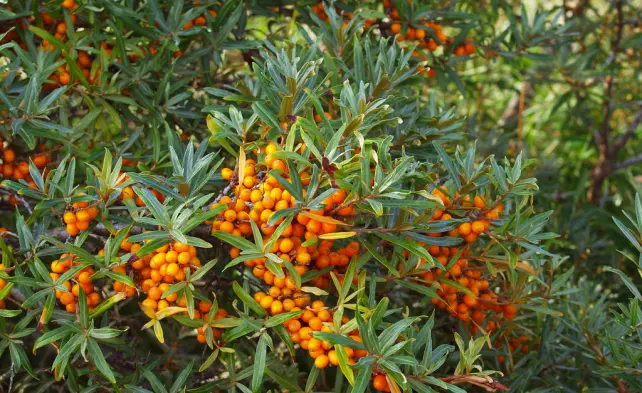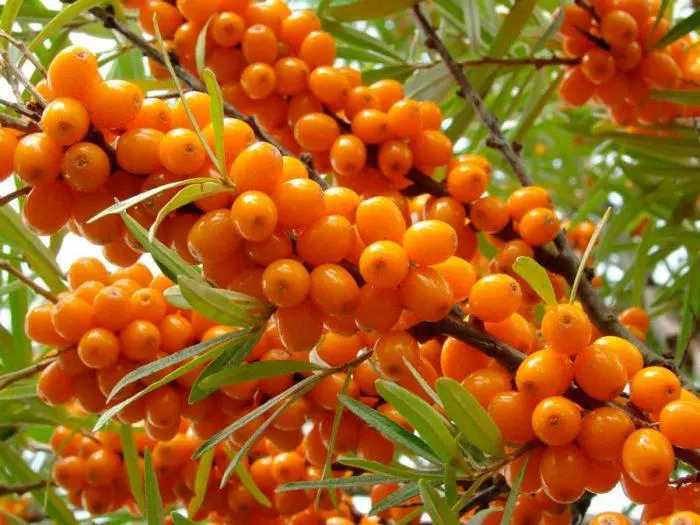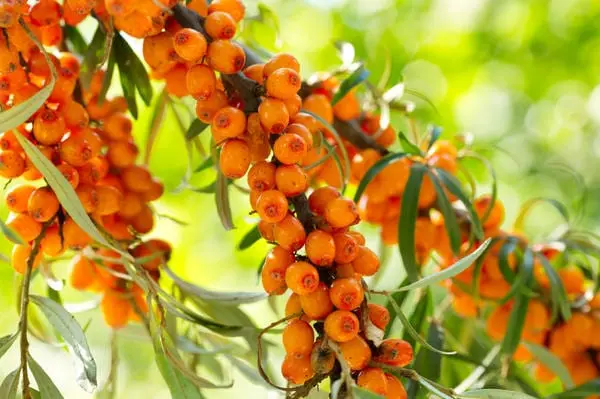Contents
Sea buckthorn is a traditional healing product of Chinese medicine and Ayurveda and a sacred fruit in the Himalayas. Its season is the time to reap all the health benefits of sea buckthorn.
Sea buckthorn (lat. Hippophae) is a genus of plants of the Elaeagnaceae. Usually, these are thorny shrubs or trees from 10 cm to 3 – 6 m high. Berries ripen on them from late August to October. Harvesting sea buckthorn is best in September – October.
90% of sea buckthorn plants grow in Eurasia, from the Atlantic coast of Europe to northeastern China. It is traditionally used in folk medicine in Russia, sea buckthorn oil is included in traditional Chinese medicine and Ayurveda, and in the Himalayas, sea buckthorn is a sacred fruit.
In English, this berry is called sea buckthorn, seaberry, sandthorn, sallowthorn.

Benefits
The berry has a high content of vitamins, minerals, antioxidants, proteins, and fiber. So, it contains 9-12 times more Vitamin C than citrus fruits. Sea buckthorn berries contain potassium, calcium, magnesium, iron and phosphorus, essential amino acids, carotenoids, as well as large amounts of folate, biotin, and vitamins B1, B2, B6, C, and E. Sea buckthorn is one of the most nutritious and vitamin-rich foods in the world. And, it’s not inferior to famous superfoods such as goji berries or acai berries.

People use sea buckthorn as a natural remedy for colds and flu. Other major benefits: weight loss, anti-aging, digestive health, treatment of infections and inflammation, and antidepressant effects, making it a truly magical berry. The berry prevents excess body fat accumulation, reduces the risk of diabetes and cardiovascular disease while helping to maintain a healthy weight. Due to its high content of vitamin C, sea buckthorn helps in collagen production, which helps to keep the skin healthy and supple and gives it a natural healthy glow. It also reduces skin irritation, redness, and itching and facilitates wound healing. Also, sea buckthorn improves digestion, reduces menopausal symptoms, dry eyes, and depression symptoms.
Oil properties
Sea buckthorn oil has been used for thousands of years as a natural remedy for various ailments. People extract it from the berries, leaves, and seeds of the plant. The oil contains all the beneficial properties of berries in a concentrated form, and you may use it both internally and externally. Interestingly, oil is probably the only plant-based product that contains all four omega fatty acids: omega-3, omega-6, omega-7, and omega-9. Its health benefits range from heart support to protecting against diabetes, stomach ulcers, and skin healing.

The oil is rich in vitamins, minerals, and especially antioxidants that help protect the body from aging and diseases such as cancer and heart disease. The seeds and leaves are especially rich in quercetin, a flavonoid associated with lower blood pressure and reduced cardiovascular disease risk. Antioxidants reduce risk factors for heart disease, including blood clots, blood pressure, and blood cholesterol levels.
The oil can also help prevent diabetes. Animal studies show that it can help lower blood sugar levels by increasing insulin secretion and insulin sensitivity. The compounds in the oil can improve your skin health when you apply them topically, including the ability to stimulate skin regeneration. The oil also has a beneficial effect on the skin after exposure to ultraviolet radiation.
Also, both berries and oil are rich in beneficial plant compounds that boost immunity and help the body fight infections such as the flu. Several oil compounds may help fight cancer as well – again, antioxidants and flavonoids, most notably quercetin, which is believed to help kill cancer cells. The oil also contains healthy fats, vitamin E, and carotenoids that can protect liver cells from damage.
Harms and contradications
The laxative effect of sea buckthorn fruits is known, so you should not lean on these fruits if you tend to diarrhea or have recently had food poisoning. If there are no contraindications, it is optimal to eat no more than 50 grams of berries at a time. From a year old, children can have a little diluted sea buckthorn juice. If you are prone to allergies under 3 years old, it is better not to risk it.
Sea buckthorn oil is beneficial for peptic ulcer disease, but doctors tend to contraindicate berries and juice. The acids in the berries greatly increase the secretion of gastric juice, which can provoke an exacerbation. For the same reason, you should not eat sea buckthorn if you have gastritis with high acidity. It would help if you did not eat berries in case of exacerbation of liver and pancreas diseases. If you have kidney or gallstones, sea buckthorn berries should be eaten with caution. Also, there is a risk of allergies.
The use in medicine
Sea buckthorn oil is very famous, and you can find it in any pharmacy. Producers prepare it by squeezing seeds from berries, although there is some oil in the pulp. People use the oil in pure form and add it to cosmetics and pharmaceutical preparations. The oil has bactericidal properties, preventing infection development on the skin with damages and mucous membranes. Also, it promotes skin regeneration. Therefore people widely use it to recover from burns and wounds. Cosmetologists recommend the oil and berry gruel as masks for the face and hair – they nourish cells and heal micro damages. People perform inhalation with its oil to treat the lungs and to lubricate the affected glands.
Sea buckthorn: recipes

The most common recipe with this berry is sea buckthorn with sugar. Another option, how you may harvest it for the winter, is to prepare it with honey. The jam from the berry is also very popular and tasty.
It is an excellent vitamin supplement for winter tea drinking. At the same time, you may prepare a tea from the sea buckthorn itself. When it’s hot outside, people make lemonade with previously harvested berries adding sugar. Sometimes you can find sea buckthorn juice on sale, and if you have fresh berries, you can make sea buckthorn juice or a smoothie with the addition of its berries yourself.
This berry is not only healthy but is also tasty. Therefore, there is a huge space for its use and culinary creativity in addition to the most popular recipes. How else can you eat sea buckthorn? You can make a sorbet, ice cream, and mousse, add it as a gravy to desserts, for example, panna cotta or cheesecake. You may also use hot tea and cold sea buckthorn lemonade as bases for alcoholic beverages such as grog and cocktails. If you want to surprise your guests, cook sea buckthorn Kurd by analogy with lemon and serve with tea. You may also use it as a filling for a shortbread tart prepared according to the recipe for a lemon curd pie.
Sea buckthorn tea with spices
This tea can be drunk hot or cold, used for healing a cold – or as a base for aromatic grog.
Ingredients:
- 100 g of sea buckthorn
- 1 tsp of grated ginger root
- 2-3 pcs. of carnation
- 2-3 boxes of cardamom
- 2 cinnamon sticks
- 500 ml of boiling water
- 2 teaspoons of honey
Sort the berries and rinse, transfer to a teapot and ceiling. Add ginger, cloves, cardamom, cinnamon. Pour boiling water over and leave for 5 minutes. Strain and serve with a teaspoon of honey per cup.
So, it is a super fruit indeed, see more reasons in this video:









